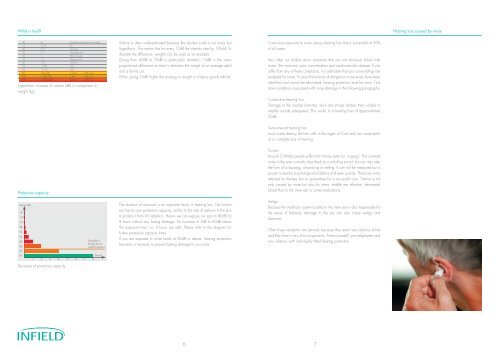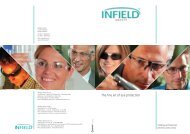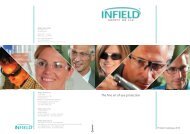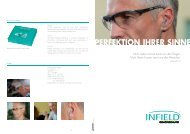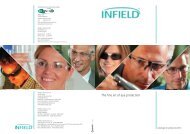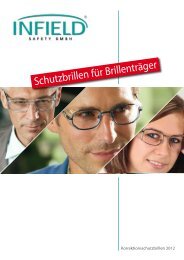Infield Gehoer 16-S GB - infield-safety
Infield Gehoer 16-S GB - infield-safety
Infield Gehoer 16-S GB - infield-safety
Create successful ePaper yourself
Turn your PDF publications into a flip-book with our unique Google optimized e-Paper software.
What is loud?<br />
Logarithmic increase of volume (dB) in comparison to<br />
weight (kg)<br />
Protective capacity<br />
Decrease of protective capacity<br />
Volume is often underestimated because the decibel scale is not linear but<br />
logarithmic. This means that for every 10dB the intensity rises by 10-fold. To<br />
illustrate the difference, weights can be used as an example.<br />
Going from 60dB to 70dB is particularly dramatic: 10dB is the same<br />
proportional difference as there is between the weight of an average adult<br />
and a family car.<br />
When going 10dB higher the analogy in weight is a heavy goods vehicle.<br />
The duration of exposure is an important factor in hearing loss. The human<br />
ear has its own protective capacity, similar to the role of melanin in the skin<br />
to protect it from UV radiation. Hence we can expose our ears to 80dB for<br />
8 hours without any lasting damage. An increase of 3dB to 83dB halves<br />
this exposure time, i.e. 4 hours are safe. Please refer to the diagram for<br />
further protective capacity times.<br />
If you are exposed to noise levels of 80dB or above, hearing protection<br />
becomes a necessity to prevent lasting damage to your ears.<br />
6 7<br />
Continuous exposure to noise causes hearing loss that is irreversible in 95%<br />
of all cases.<br />
Very often our bodies show symptoms that are not obviously linked with<br />
noise, like insomnia, poor concentration and cardiovascular disease. If you<br />
suffer from any of these complaints, it is advisable that your surroundings are<br />
analysed for noise. In case that sources of dangerous noise levels have been<br />
identified and cannot be eliminated, hearing protection must be worn. Find<br />
more conditions associated with noise damage in the following paragraphs.<br />
Conductive hearing loss<br />
Damage to the ossicles (hammer, anvil and stirrup) renders them unable to<br />
amplify sounds adequately. This results in a hearing loss of approximately<br />
20dB.<br />
Sensorineural hearing loss<br />
Loud noises destroy the hair cells in the organ of Corti and can cause partial<br />
or complete loss of hearing.<br />
Tinnitus<br />
Around 3 Million people suffer from tinnitus (Latin for ‚ringing’). This constant<br />
noise in the ears is mostly described as a whistling sound, but can also take<br />
the form of a buzzing, whooshing or rattling. It can not be measured but is<br />
proven to lead to psychological problems and even suicide. There are many<br />
attempts for therapy but no guarantees for a successful cure. Tinnitus is not<br />
only caused by noise but also by stress, middle ear infection, decreased<br />
blood flow to the inner ear or some medications.<br />
Vertigo<br />
Because the vestibular system located in the inner ear is also responsible for<br />
the sense of balance, damage to the ear can also cause vertigo and<br />
dizziness.<br />
Often these symptoms are ignored, because they aren’t very obvious at first<br />
and they have a very slow progression. Protect yourself, your employees and<br />
your relatives with individually fitted hearing protection.<br />
Hearing loss caused by noise


